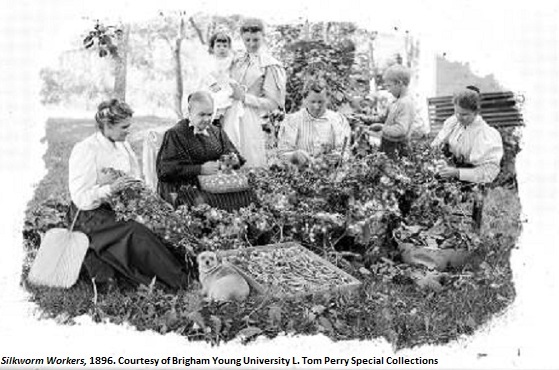Dublin Core
Title
Description
Have you ever noticed groves of mulberry trees in your neighborhood? These trees aren’t native to Utah, but were planted to support a pioneer silk industry led by Mormon women and girls.
It’s hard to imagine silkworms thriving in Utah’s harsh desert climate, but in the late 1800s, silk production in Utah was in full swing. And the hands behind this technical and tedious work belonged not to ambitious businessmen, but to Mormon women and their daughters.
Self-sufficiency was an important part of Brigham Young’s vision for Mormon settlers in Utah. Instead of purchasing goods from outside markets, he encouraged them to make what they needed by developing new industries. One of these new ventures was sericulture, which is the process of raising silkworms and harvesting their cocoons.
Sericulture is extremely demanding work, and many women and girls became experts. One of these experts was twelve-year-old Ann Clarke, who learned the art of sericulture from her mother Ellen, who raised silkworms in their American Fork home. To keep the worm eggs warm until they hatched, women put them into pouches that they wore everywhere around their necks. Once hatched, the worms were fed fresh mulberry leaves for about 40 days until they spun themselves into a cocoon. Then, the women boiled the cocoons to kill the moth and release the tiny, nearly invisible silk filaments, using their fingers to unravel the delicate threads and coil them around wooden paddles. It took about 30,000 worms to produce 12 pounds of raw silk.
By 1879, Ann Clarke was so skilled at silkworm care that she was sent to Salt Lake City to learn the specialized art of silk reeling, where the filaments were carefully guided through tension wheels and twisted together to become skeins ready to weave into fabric. When Ann returned home, she was put in charge of all silk reeling in Utah County.
The silk industry in Utah was short-lived, since it became cheaper – and much easier – to import silk from other places. By 1906, the sericulture experiment had ended, but Utah-grown silk lives on in museums and in the legacies of those women and girls whose hard work, patience, and skill made Utah sericulture possible.
Creator
Karen and Dan Adams for the American Fork Daughters of Utah Pioneers Museum © 2017
Source
_______________
See Chris Rigby Arrington, “The Finest of Fabrics: Mormon Women and the Silk Industry in Early Utah,” Utah Historical Quarterly, Vol. 46, No. 4, 1978, pp 376-396; Ardis E. Parshall, “A Child’s-Eye View of the Mormon Silk Experiment,” Keepapitchinin Blog, February 2, 2009, http://www.keepapitchinin.org/2009/02/02/a-childs-eye-view-of-the-mormon-silk-experiment/, accessed 9/12/2017; and American Fork Daughters of Utah Pioneers Museum, exhibition file for “The REEL Story of Silk,” curated by Karen and Dan Adams, 2012.

